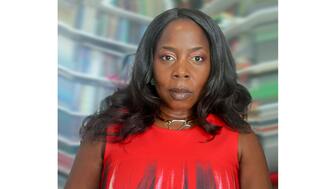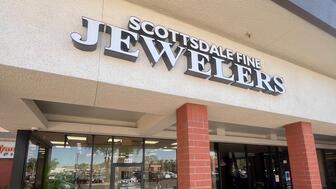“Shell Auranova” is the next generation of the brand’s bridal line, featuring half-bezel engagement rings with bold and fluid designs.
Why Omnichannel Retail is Key to Success in 2017
According to Fitch Ratings and the Harvard Business Review, a combination of online and in-store sales will make all the difference in the year ahead.

New York--Analysts agree that an omnichannel approach to retail is integral to success in 2017.
According to global credit rating and research firm Fitch Ratings, U.S. retail sales, excluding automobiles and gasoline, will increase 3 to 4 percent this year, with more than half of that growth concentrated online and about 1 percent of it relegated to in-store sales.
David Silverman, Senior Director, U.S. Corporates at Fitch Group, explained in the 2017 outlook report, “Spending focus on services and experiences appears here to stay, so the dividing line between best-in-class retailers and market share donors is increasingly going to be determined by which retailers can cater to the evolving landscape.”
He continued, “Those that find success have invested in the omnichannel model and have differentiated their products and customer service to draw customers in.”
A recent Harvard Business Review (HBR) study shed similar light on the importance of omnichannel retail.
The HBR tracked 46,000 consumers who made a purchase between the 14-month period of June 2015 and August 2016.
Of the participants, 73 percent were omnichannel customers who shopped both in-store and online, while 20 percent shopped only in-store and 7 percent only online.
The study found that the omnichannel customers were using multiple technological tools provided by retailers, referred to as touchpoints.
Examples of different touchpoints include ordering a product online and picking it up in a store, using a smartphone app to pull up a coupon, or even utilizing in-store tools like interactive catalogs, price-checkers and tablets.
The HBR categorized each of these various touchpoints as separate retail channels.
They concluded that the more channels a customer used, the more they were spending. On average, consumers spent 4 percent more in store and 10 percent more online if they had interacted with multiple channels as opposed to a single channel (only making a purchase online or only making a purchase in-store).
Customers that used four or more channels before making a purchase spent an average of 9 percent more in a store.
“Spending focus on services and experiences appears here to stay, so the dividing line between best-in-class retailers and market share donors is increasingly going to be determined by which retailers can cater to the evolving landscape.”--David Silverman, Fitch Group
The study also showed that rather than perusing merchandise in a store and buying online, it was more common for consumers to compare product online
If customers had conducted online research, whether at a retailer’s website or other websites, prior to a purchase, they typically spent 13 percent more in store.
Retailers See Success
Dallas, Texas-based fine jeweler Ylang 23 opened up shop in 1985 and was an early e-commerce convert, adding their online store to their website in 2001.
Ylang 23 had always taken a multi-channel approach to business, building up store traffic in the 1980s and 1990s through direct mail advertising. Now, the store feels so strongly about their online business that they carry the exact same merchandise online and in-store.
“More often than not, customers will come in having already done a large chunk of pre-shopping online or through our social channels, particularly our Instagram,” Vice President of Business Development Alysa Teichman said.
“We are really finding that our store strengthens our online business and vice versa. It’s nice to have a platform where our customers can shop in their pajamas at home and then get that touch point and excellent customer service we’re known for in-store.”
Harold Stevens Jewelers, located in San Diego, California, opened for business in 1979 and added an online e-commerce site in 2015.
Ryan Krasner, the store’s creative director, emphasized that the site is “still in its infancy,” and only accounts for about 5 percent of total sales, though Krasner is “pursuing different avenues to improve online transactions.”
However, like Ylang 23, many of Harold Stevens Jewelers’ clients have perused the website before coming in to shop.
“In the local market,” he explained, “mainly people are on the website, then come in to physically handle the product and experience it in person.”
Social media channels like Instagram, to which Harold Stevens Jewelers pays special attention, given the visual nature of the platform, also play a big part in drawing in foot traffic.
“(Customers) check out all channels if they’re interested,” Krasner said.
Even some new retailers that began as e-commerce-only businesses are embracing the omnichannel approach.
Goldyn, a store that sells women’s and men’s apparel plus fine jewelry by brands like Communion by Joy and Selin Kent, is a product of the digital age. The store launched in 2007 as an online-only retailer.
“Fine jewelry is particularly important to our online business because there aren’t the issues with fit and feel that you have with apparel,” said Vanessa Barcus, Goldyn’s owner. “I find that customers are not reluctant to buy fine jewelry online, especially if they are already familiar with the designer.”
Barcus had always hoped to have a physical retail space as well, and waited out the first few post-2008 recession years before opening her Denver, Colorado, store in 2011.
“I’d say it’s quite important to have both an online store and brick-and-mortar shop,” Barcus said. “The two really support each other. Especially with fine jewelry purchases, I find that customers have done a lot of research online and have already perused our website before stopping in. Even if the purchase is not made online, having the products there allows the customers to think about the purchase, which can help make the sale for us.
“Or, vice versa, if a customer comes in and sees something they like in the shop, but it’s a bigger purchase and they want to think about it more, our website allows them to purchase it at a later date.”
Barcus said that “a significant volume of overall sales, particularly fine jewelry sales,” are made online.
Like Goldyn, Ylang 23 relies on the synergy between e-commerce and their physical store to keep their customers’ attention in a changing retail landscape.
But even with more focus than ever on all manner of online and digital sales, Ylang 23 is not neglecting their very first retail channel.
“Eventually, we’d like to add other physical retail locations,” Teichman said. “We believe in brick-and-mortar stores. The direct, customer-facing, customer service aspect is just so important to us.”
The Latest

Boucheron and Pomellato performed well in an otherwise bleak quarter for Kering amid struggles at Gucci.

Designer Deborah Meyers created her birds from oxidized sterling silver, rose-cut diamond eyes, and Akoya Keshi pearl feathers.

Six new retail businesses were selected for the 2025 program, which began in January.

The company said it expects sightholders to remain “cautious” with their purchasing due to all the unknowns around the U.S. tariffs.


Sponsored by the Gemological Institute of America

Simon Wolf shares why the time was right to open a new office here, what he looks for in a retail partner, and why he loves U.S. consumers.

The risk of laboratory-grown diamonds being falsely presented as natural diamonds presents a very significant danger to consumer trust.

A third-generation jeweler, Ginsberg worked at his family’s store, Ginsberg Jewelers, from 1948 until his retirement in 2019.

The company failed to file its quarterly reports in a timely manner.

The organization also announced its board of directors.

Charms may be tiny but with their small size comes endless layering possibilities, from bracelets to necklaces and earrings.


Located in Valenza, the now 355,000-square-foot facility includes a new jewelry school that’s open to the public, Scuola Bulgari.

Paola Sasplugas, co-founder of the Barcelona-based jewelry brand, received the Fine Jewelry Award.

A platinum Zenith-powered Daytona commissioned in the late ‘90s will headline Sotheby’s Important Watches sale in Geneva next month.

The basketball stars wear men’s jewelry from the “Curb Chain” collection.

The Signet Jewelers-owned retailer wants to encourage younger shoppers to wear fine jewelry every day, not just on special occasions.

The 21 pieces, all from a private collector, will be offered at its Magnificent Jewels auction next month.

Lilian Raji answers a question from a reader who is looking to grow her jewelry business but has a limited marketing budget.

GCAL by Sarine created the new role to sharpen the company’s focus on strategic partnerships and scalable expansion.

The Indiana jeweler has acquired Scottsdale Fine Jewelers in Scottsdale, Arizona.

“Cartier: Design, Craft, and Legacy” opened earlier this month at the Victoria and Albert Museum in London.

Van Cott Jewelers in Vestal, New York, is hosting a going-out-of-business sale.

Industry veteran Samantha Larson has held leadership roles at Borsheims, McTeigue & McClelland, Stuller, and Long’s Jewelers.
The two organizations will hold the educational event together this fall in Mississippi.

The entrepreneur and “Shark Tank” star will share his top tips for success.

The Ukrainian brand’s new pendant is modeled after a traditional paska, a pastry often baked for Easter in Eastern European cultures.



























